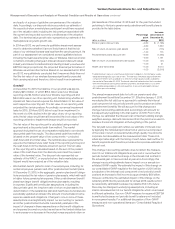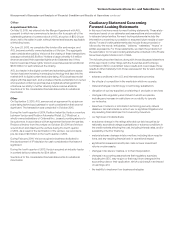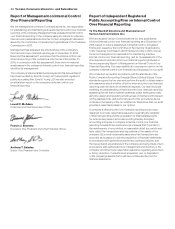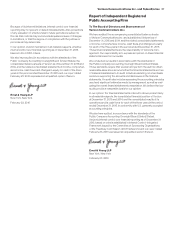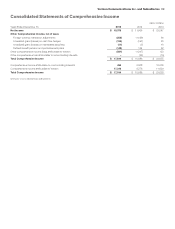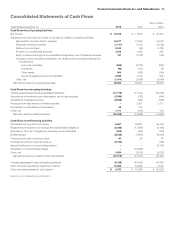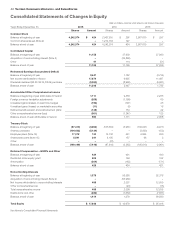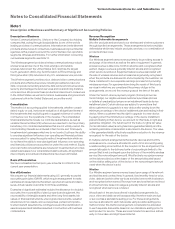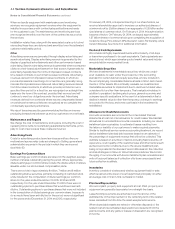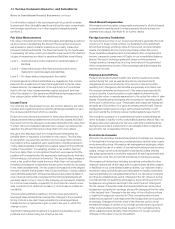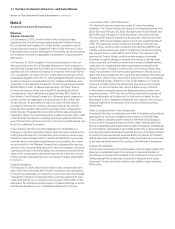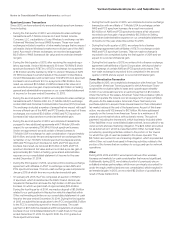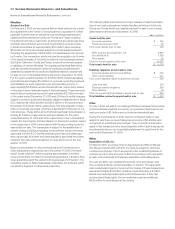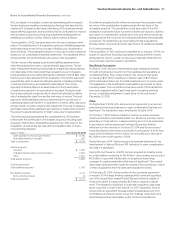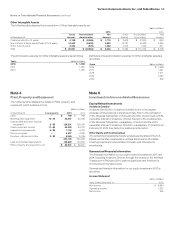America Online 2015 Annual Report Download - page 45
Download and view the complete annual report
Please find page 45 of the 2015 America Online annual report below. You can navigate through the pages in the report by either clicking on the pages listed below, or by using the keyword search tool below to find specific information within the annual report.Notes to Consolidated Financial Statements
Note1
Description of Business and Summary of Significant Accounting Policies
Description of Business
Verizon Communications Inc. (Verizon or the Company) is a holding
company that, acting through its subsidiaries, is one of the world’s
leading providers of communications, information and entertainment
products and services to consumers, businesses and governmental
agencies with a presence around the world. We have two reportable
segments, Wireless and Wireline. For further information concerning
our business segments, see Note13.
The Wireless segment provides wireless communications products
and services across one of the most extensive and reliable
wireless networks in the United States (U.S.) and has the largest
fourth- generation (4G) Long-Term Evolution (LTE) technology and
third- generation (3G) networks of any U.S. wireless service provider.
The Wireline segment provides voice, data and video communications
products and enhanced services, including broadband video and
data, corporate networking solutions, data center and cloud services,
security and managed network services and local and long distance
voice services. We provide these products and services to consumers
in the United States, as well as to carriers, businesses and government
customers both in the United States and around the world.
Consolidation
The method of accounting applied to investments, whether consoli-
dated, equity or cost, involves an evaluation of all significant terms of
the investments that explicitly grant or suggest evidence of control
or influence over the operations of the investee. The consolidated
financial statements include our controlled subsidiaries, as well as
variable interest entities (VIE) where we are deemed to be the primary
beneficiary. For controlled subsidiaries that are not wholly-owned, the
noncontrolling interests are included in Net income and Total equity.
Investments in businesses which we do not control, but have the ability
to exercise significant influence over operating and financial policies,
are accounted for using the equity method. Investments in which we
do not have the ability to exercise significant influence over operating
and financial policies are accounted for under the cost method. Equity
and cost method investments are included in Investments in unconsol-
idated businesses in our consolidated balance sheets. All significant
intercompany accounts and transactions have been eliminated.
Basis of Presentation
We have reclassified certain prior year amounts to conform to the
current year presentation.
Use of Estimates
We prepare our financial statements using U.S. generally accepted
accounting principles (GAAP), which require management to make
estimates and assumptions that affect reported amounts and disclo-
sures. Actual results could differ from those estimates.
Examples of significant estimates include: the allowance for doubtful
accounts, the recoverability of plant, property and equipment, the
recoverability of intangible assets and other long-lived assets, fair
values of financial instruments, unrecognized tax benefits, valuation
allowances on tax assets, accrued expenses, pension and postre-
tirement benefit assumptions, contingencies and the identification of
assets acquired and liabilities assumed in connection with business
combinations.
Revenue Recognition
Multiple Deliverable Arrangements
We offer products and services to our wireless and wireline customers
through bundled arrangements. These arrangements involve multiple
deliverables which may include products, services, or a combination of
products and services.
Wireless
Our Wireless segment earns revenue primarily by providing access to
and usage of its network as well as the sale of equipment. In general,
access revenue is billed one month in advance and recognized when
earned. Usage revenue is generally billed in arrears and recognized
when service is rendered. Equipment sales revenue associated with
the sale of wireless devices and accessories is generally recognized
when the products are delivered to and accepted by the customer, as
this is considered to be a separate earnings process from providing
wireless services. For agreements involving the resale of third-party
services in which we are considered the primary obligor in the
arrangements, we record the revenue gross at the time of the sale.
Under the Verizon device payment program (formerly known as
Verizon Edge), our eligible wireless customers purchase phones
or tablets at unsubsidized prices on an installment basis (a device
installment plan). Certain devices are subject to promotions that
allow customers to upgrade to a new device after paying down the
minimum percentage of the device installment plan and trading in their
device. When a customer has the right to upgrade to a new device
by paying down the minimum percentage of the device installment
plan and trading in their device, we account for this trade-in right as a
guarantee obligation. The full amount of the trade-in right’s fair value
(not an allocated value) is recognized as a guarantee liability and the
remaining allocable consideration is allocated to the device. The value
of the guarantee liability effectively results in a reduction to the revenue
recognized for the sale of the device.
In multiple element arrangements that bundle devices and monthly
wireless service, revenue is allocated to each unit of accounting using
a relative selling price method. At the inception of the arrangement, the
amount allocable to the delivered units of accounting is limited to the
amount that is not contingent upon the delivery of the monthly wireless
service (the noncontingent amount). We effectively recognize revenue
on the delivered device at the lesser of the amount allocated based
on the relative selling price of the device or the noncontingent amount
owed when the device is sold.
Wireline
Our Wireline segment earns revenue based upon usage of its network
and facilities and contract fees. In general, fixed monthly fees for voice,
video, data and certain other services are billed one month in advance
and recognized when earned. Revenue from services that are not fixed
in amount and are based on usage is generally billed in arrears and
recognized when service is rendered.
We sell each of the services offered in bundled arrangements (i.e.,
voice, video and data), as well as separately; therefore each product
or service has a standalone selling price. For these arrangements,
revenue is allocated to each deliverable using a relative selling price
method. Under this method, arrangement consideration is allocated
to each separate deliverable based on our standalone selling price for
each product or service. These services include Fios services, individ-
ually or in bundles, and High Speed Internet.
43Verizon Communications Inc. and Subsidiaries


